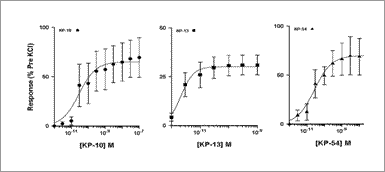Discovery of kisspeptins, ligands for the orphan g-protein coupled receptor KISS1, as potent vasoconstrictors in rat aorta Orphan G-protein coupled receptor KISS1 (GPR54) has been paired with kisspeptin (KP)-54, and additional products of the metastasis suppressor gene KiSS-1, KP-14, KP-13 and KP-10 (Ohtaki et al., 2001) . KPs are potent suppressors of metastasis, have a role in placentation and were recently identified as a molecular switch for puberty through KISS1 (Lee et al., 1996; Seminara et al., 2003) . Intriguingly we discovered, through extensive profiling of cardiovascular (CV) tissue by RT-PCR and immunocytochemistry (ICC), that KISS1 was discretely expressed on smooth muscle of human aorta, coronary artery (CA) and umbilical vein (UV), tissues embryonically derived from the aorta-gonad-mesonephros (AGM), but not in other large conduit vessels screened. Smooth muscle expression suggested a functional role of KPs, in these vessels, which we aimed to test in a rat aorta model. Fluorescence dual labelling ICC was carried out on human aorta, CA and UV using anti-KISS1R (375-398) (human) serum or anti-Kp-10-NH2 (human) serum as previously described (Davenport et al., 2005). For autoradiography experiments human aorta sections were incubated 2 hours at 23 ºC with 0.5nM 125 IKP-13. Non-specific binding was determined by inclusion of 10μM KP-13 (Davenport et al., 2005). Isolated rings (4mm) of thoracic aorta from male Wistar rats (200-220g) were bathed in oxygenated Krebs’ solution and isometric force measurements taken. Optimum resting tension was determined by responses to 100mM KCl at incrementally increasing levels of basal tension. Cumulative concentration-response curves were constructed to KP-10, KP-13 and KP-54 (1x10-12-3x10-7) and terminated by addition of 100mM KCl to determine maximum contractile response. Agonist responses were expressed as % pre KCl response. Data were fitted to a four parameter logistic equation and compared using one-way analysis of variance (ANOVA, significance P<0.05).
Fig. 1. Constrictor activity of KP-10, KP-13 and KP-54 in rat aorta. Data are mean ± s.e.mean, n = number of aortas in which responses were recorded. Specific binding of KISS1 peptide was detected in human aorta (n=6) by quantitative autoradiography and image analysis; the cellular localisation to smooth muscle was confirmed by fluorescence dual labelling ICC in this artery as well as CA and UV. In rat aorta pD 2 values, maximum response (Fig. 1), the initial response to KCl and terminal KCl responses for KP-10, KP-13 and KP-54 were not significantly different (P<0.05) We have shown for the first time, using a rat aorta model, that KP-10, KP-13 and KP-54 are equipotent and equiefficacious vasoconstrictors in vitro.
Davenport , A.P., et al. (2005). Methods in Molecular Biology 306 93-120, 155-172. |


